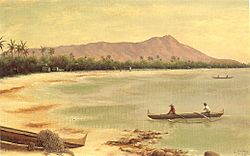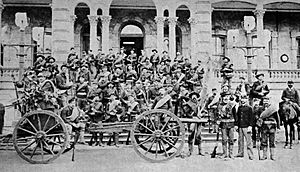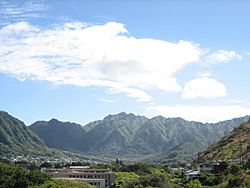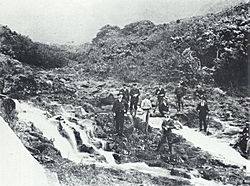1895 Wilcox rebellion facts for kids
Quick facts for kids 1895 Wilcox rebellion |
|||||||
|---|---|---|---|---|---|---|---|
| Part of the Hawaiian rebellions (1887–1895) | |||||||
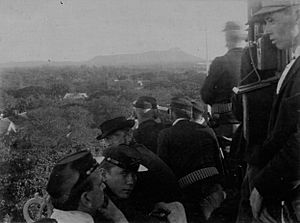 National Guardsmen atop ʻIolani Palace during the Battle of Kamoiliili. |
|||||||
|
|||||||
| Belligerents | |||||||
| Commanders and leaders | |||||||
| Sanford B. Dole Edward G. Hitchcock |
Samuel Nowlein (POW) Robert W. Wilcox (POW) |
||||||
| Strength | |||||||
| 1,200 500 Citizens' Guards 5 Companies National Guard of Hawaii 2 Companies, Regular Army Police Force |
400–500 | ||||||
| Casualties and losses | |||||||
| 1 killed | Several killed 190–220 captured Most deserted |
||||||
The 1895 Wilcox rebellion, also called the Counter-Revolution of 1895, was a short conflict in Hawaii. It happened from January 6 to January 9, 1895. This rebellion involved three battles on the island of Oʻahu, which was then part of the Republic of Hawaii.
This event was the last big effort by people who supported the Hawaiian monarchy. They wanted to bring back the Kingdom of Hawaii after it had been overthrown. Because it was so short and had few deaths, this conflict is often not well-known.
Contents
How the Republic of Hawaii Started
After the 1887 Hawaiian Constitution and the 1893 overthrow of the monarchy, a new temporary government was set up. This government, called the Provisional Government of Hawaii, hoped that the United States would soon take over Hawaii.
They worked with U.S. President Benjamin Harrison to create a treaty for Hawaii to join the U.S. However, President Harrison's time in office ended before the treaty could be approved. The next president, Grover Cleveland, did not want Hawaii to become part of the U.S. He believed the U.S. had used its military unfairly in Hawaii. President Cleveland wanted Queen Liliʻuokalani to be put back on the throne.
The Provisional Government worried that President Cleveland would try to restore the queen. They also knew that Hawaii would not be annexed while Cleveland was president. So, they decided to create a more permanent government. On July 4, 1894, they announced the creation of the Republic of Hawaii. This new government was controlled by a small group of people.
Royalist Plans to Restore the Monarchy
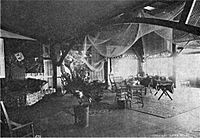
In 1895, Robert William Wilcox joined a secret plan to overthrow the Republic of Hawaii. The goal was to bring Queen Liliʻuokalani back to power. Other people involved included Samuel Nowlein, who used to lead the Royal Guards, and Joseph Nawahi, a former government minister.
These plotters planned to attack government buildings in Honolulu at night. They tried to gather 700 people for their rebellion, mostly poor Native Hawaiians who worked as day laborers. However, they didn't get enough people. Also, their recruits did not have many weapons, training, or discipline. The Republic's government, on the other hand, had spent a lot of money to arm itself well against any attack.
The rebels believed they had secretly sent weapons to Queen Liliʻuokalani. These weapons were supposed to be given to them once they took over the palace. A shipment of guns and ammunition was smuggled from California. It was moved from one ship to another near Rabbit Island and then sent to a secret spot in Honolulu.
The Battle of Diamond Head
On January 6, 1895, rumors spread that weapons were being brought ashore at Waikīkī beach on Oʻahu. A group of six policemen, led by Captain Parker, went to Henry Bertelmann’s house near Diamond Head. They were looking for weapons. They did not know that Bertelmann was a leader in the rebellion.
As the police tried to search the house, three royalists returning from the beach fired at them. The royalists hid in Bertelmann’s canoe house. The police moved forward, forcing the royalists to leave. However, Charles L. Carter, a civilian with the police, was shot three times. Bertelmann also shot and wounded police lieutenant Holi.
The police captured Bertelmann and another rebel, John Carey Lane. They then took shelter in Bertelmann’s house. About 70 royalists in the area joined the fight, attacking the house. They were led by Colonel Robert Wilcox and Lieutenant Lot Lane. The royalists surrounded the house, but three men escaped: Captain Parker, Deputy Marshal Brown, and Alfred Carter (Charles Carter's cousin).
The police officers rode their horses to get help. Alfred Carter went to find a doctor for his cousin. A group of soldiers from the National Guard of Hawaii pushed the royalists back towards Diamond Head. This allowed doctors to reach Charles Carter. The battle continued into the night. The royalists managed to push the soldiers back from their hiding spot. By the morning of January 7, the government forces pulled back to Sans Souci Beach in Waikiki. They waited for more soldiers, ending the battle.
Charles L. Carter died later that day from his injuries. Two other police officers were also hurt. Bertelmann and Lane were arrested and sent to jail. Even though the royalists won this first battle, they lost the element of surprise. This meant their victory would not last long.
The Battle of Mōʻiliʻili
On January 7, 1895, the Republic’s President, Sanford B. Dole, declared martial law in Hawaii. This meant the military took control. Lt. Sam Nowlein’s men met up with Col. Robert W.K. Wilcox at Diamond Head. After the government’s loss in the first battle, Marshal Edward G. Hitchcock sent soldiers and three cannons to stop the royalists from marching on Honolulu.
More soldiers were sent and met near Sans Souci Beach at Kapiolani Park. One group of soldiers went to the top of Diamond Head to attack the royalists from above. Another group used a cannon to target about 100 royalists on the volcano's slopes. The cannon was not very accurate at first. It took several shots to make Wilcox’s men move. One shot even missed Diamond Head completely and landed in the sea! The last cannon fire caused some injuries and scattered the group. Wilcox decided it was not important to stay on Diamond Head. He ordered his men to retreat to Waialae to rest. Their new plan was to move north into the Koʻolau mountains and then west, avoiding the government forces in the south.
Nowlein's men fired at a group of police along Waialae Road, but no one was hurt. The police still pulled back. The Republic’s army moved toward the royalists with two cannons. The third cannon was put on a tugboat called Eleu to make a small Patrol Boat. The Eleu attacked Wilcox’s men with grapeshot at Waialae. The royalists were gathered around Anton Rosa’s house, which used to be their main base and had an arms cache (a hidden store of weapons). This house was captured.
Nowlein's men were supposed to capture Punchbowl. But they had been hiding as government troops moved toward Diamond Head. The police group on Waialae Road was sent toward their position. When the police got close, Nowlein's men fired at them, and the police retreated. The police returned with more soldiers and fought Nowlein at Kaimuki as they moved toward Moʻiliʻili. Nowlein's men were pushed back to Mauʻumae, where they had hidden weapons and boulders for cover. The fighting became a stalemate, meaning neither side could hurt the other. Finally, the government forces broke through when a larger cannon was brought in. Thirty-three of Nowlein's men surrendered. Nowlein himself escaped with some officers.
As the Eleu attacked Waialae, Wilcox moved his men through the mountains toward Honolulu. His men reached the area of Moʻiliʻili, at the entrance of Mānoa Valley. There, they met a line of government soldiers and faced cannon fire. More government soldiers moved to cut off the royalists' western path. The royalists retreated and hid among stone walls and plants. Wilcox waited for Nowlein's attack on Punchbowl to help his men, but it never came. The royalists could not hold their ground and retreated into the valley. At the end of the battle, 40 royalists surrendered and were taken prisoner. One government soldier was wounded. The battle lasted a day, and several royalists were killed.
The Battle of Mānoa
The last battle happened on January 9. The royalists had pulled back after losing at Moʻiliʻili. Wilcox now had only about 100 men left and retreated into Mānoa Valley. Most of Wilcox's men had not eaten since the rebellion started, and their spirits were low. The government forces did not chase them right away. This was because a small riot had started among Japanese plantation workers in ʻEwa. The government sent some soldiers there instead.
Scouting groups were sent into and around the Koʻolaus. They found that the royalist force was still in Mānoa Valley. The tugboat Eleu patrolled the coast and destroyed any suspicious empty boats. The remaining government forces were ordered to guard the valley entrance to keep the royalists trapped.
On the evening of January 9, a royalist group of 50 men was seen trying to climb Tantalus. They wanted to move through Punchbowl to enter the city. A gun battle started between government soldiers and the royalists. One royalist was killed. The royalists were pushed to the back of the valley, where mountains surrounded them on three sides. Until nightfall, this trapped group faced a siege and cannon fire. They were in a small area known as “the Pen,” at the base of Puʻu Konahuanui. The royalists then climbed the steep slopes to escape under the cover of darkness. The battle lasted three hours. Two rebels were captured, three were confirmed dead, and most managed to escape.
After climbing the ridge, the royalists' futures varied. Many felt the rebellion had failed and simply left. Others wanted to keep fighting but were separated from Wilcox. They were eventually captured or killed by government forces. Wilcox traveled along old paths to Nuʻuanu Valley and Kalihi. His group of 10 eventually broke up.
What Happened Next
Small fights continued for a week after the victory in Mānoa. The military cleared out areas where rebels were still hiding in the Koʻolaus. Even though Hawaii's tropical forests look like they have a lot of food, many plants are not good to eat. So, most rebels were forced out by hunger.
All the royalist leaders were arrested. A military building was turned into a prison for the captured rebels. On January 8, 1895, the captain of the Steamer Waimanalo, William Davies, and some crew members were arrested for giving weapons to the rebels.
Nowlein was caught with three other leaders on January 14 in Moʻiliʻili. Native Hawaiian people who supported the monarchy had been secretly feeding them while they were hiding.
Wilcox hid for several days in the mountains. He then made his way to Nuʻuanu Valley and Kalihi with 10 loyal followers, but the group broke up. He surrendered on January 16, 1895, in a fishing hut near Kalihi.
Lane hid in the Koʻolaus above Mānoa for ten days after the last battle. He came out of hiding when the fighting stopped. He thought that a foreign country had come to help. But after asking someone, he found out the rebellion was crushed. Lane surrendered peacefully to the police. He was the last rebel to be captured. When he was brought to police headquarters, six guards escorted him. They were afraid he might overpower the usual number of guards. He was locked up with over a hundred hungry prisoners. That night, he used the guards’ fears about him to get food for his fellow inmates. It was believed that many royalists had avoided capture. Their identities were not known, so they simply returned to their lives before the rebellion.
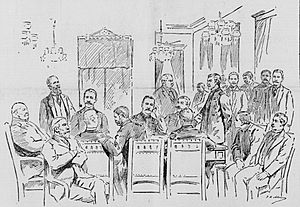
A hidden stash of weapons was found and linked to Queen Liliʻuokalani. She was arrested on January 16. Wilcox was put on trial for treason, just like after the Wilcox Rebellion of 1889. This time, he was found guilty and sentenced to death, but his sentence was changed to 35 years in prison. Queen Liliʻuokalani and other political leaders were also tried and found guilty of helping to hide the plot against the government.
The former attorney general of the Kingdom, Paul Neumann, was their lawyer. The prosecutor was William Ansel Kinney. To prevent more fighting over the government, Queen Liliʻuokalani formally gave up her throne in a five-page letter on January 24, 1895. The president of the Republic, Sanford B. Dole, later pardoned the royalists after they had served some of their prison time.
|


